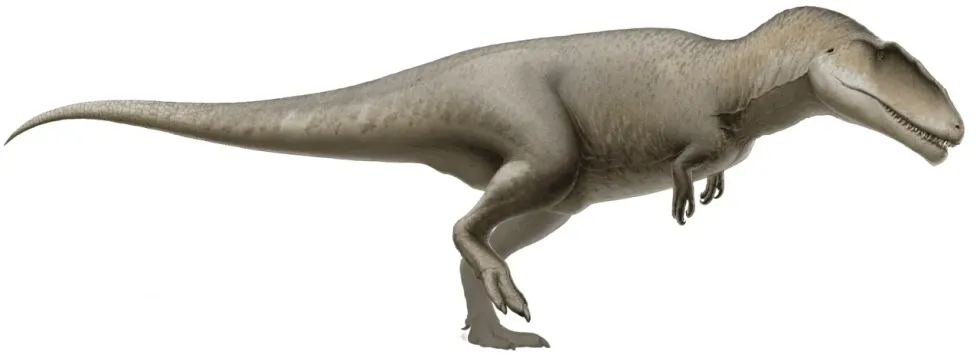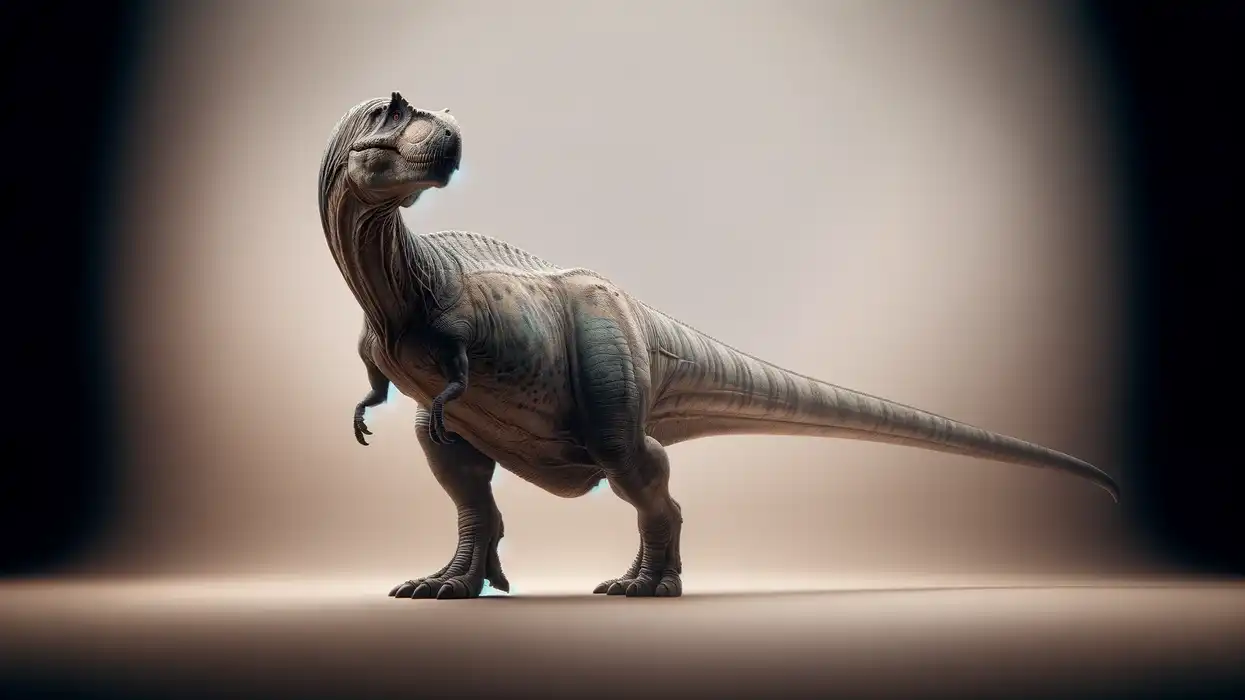The Carcharodontosaurus, aptly named 'shark-toothed lizard' for its stunningly serrated dentition, stood as a testament to the sheer diversity and terrifying predatory prowess found among theropod dinosaurs of the Late Cretaceous Period (100.5-93 million years ago).
Residing in what is now known as North Africa, these formidable beasts were among the largest of their kind, with sizes rivaling even the infamous Tyrannosaurus rex.
Their discovery, marked by the unearthing of two distinctive teeth amid the turmoil of World War II, initially offered only a glimmer into the lives of these ancient creatures.
However, as paleontology progressed, more substantial evidence came to light, revealing that the shark-toothed giant was not just a formidable predator, but also a complex organism adapted to its environment.
Further fossils, including partial skulls and a variety of skeletal elements, have since been excavated from places such as the Continental Intercalaire Formation.
These finds have afforded many paleontologists deeper insights into the life and times of these giants, suggesting that the massive theropods thrived in vast, river-laden landscapes offering abounding prey and diverse ecological niches.
Understanding the nuances of this theropod's life is critical to comprehending the ecosystem of North Africa during the Cretaceous. The fearsome carnivore likely dominated its territories, leveraging its jaw strength, comparable to that of modern sharks, to take down prey with ruthless efficiency.
The imposing predator's impressive dentition was not just for show; each tooth was a finely-tuned tool for slicing through flesh, indicating a predatory strategy that focused on delivering powerful, disabling bites to its victims.
Ironically, the fossils of the colossal hunter were unearthed in the wake of human conflict, yet they serve as humbling reminders of a time when such colossal beasts roamed the Earth, uncontested.
Today, Carcharodontosaurus fossils help humans piece together a narrative of the powerful carnivore's life, from the land they roamed, marked by the climatic sways between hot, humid weather patterns, to the competition they faced from other large theropods of the era.
It's an ever-evolving story, one that continues to enrich human understanding of the Cretaceous world and the lineage that connects these ancient rulers to the modern birds seen today.
Carcharodontosaurus Interesting Facts
 Shutterstock
Shutterstock
How do you pronounce 'Carcharodontosaurus'?
The correct pronunciation of Carcharodontosaurus is 'Kar-karo-don-to-saw-rus'.
What type of dinosaur was it?

Carcharodontosaurus was a genus of carnivorous theropod dinosaurs.
In which geological period did this dinosaur roam the Earth?
It roamed the Earth during the Late Cretaceous Period (99-94 million years ago).
When did the Carcharodontosaurus become extinct?
Carcharodontosaurus became extinct approximately 93 million years ago.
Where did this dinosaur live?

Carcharodontosaurus lived in the regions that are now known as North Africa.
What was their habitat?
They inhabited riparian zones and coastal regions, which had a hot and humid climate conducive to their survival.
Who did they live with?
Indications are that Carcharodontosaurus, like other sizable theropods, might have engaged in group hunting tactics to enhance their probability of overpowering larger prey.
The theory that they exhibited social hunting behaviors gains credence from the discovery of Carcharodontosaurus bite marks on a Spinosaurus's sail in the fossil record, which not only suggests they had aggressive encounters with other formidable predators but also implies potential cooperative hunting strategies.
How long did this live?
The lifespan of Carcharodontosaurus is not known with certainty, but it may have lived for several decades based on comparisons with similar dinosaurs.
How did they reproduce?

Carcharodontosaurus likely laid eggs, similar to other theropods, but specific details about their reproductive habits are not known.
Carcharodontosaurus Fun Facts
What did they look like?
The Carcharodontosaurus was known for its formidable size and sharp, serrated teeth. The physical build suggested power and agility, with strong limbs for a bipedal stance and a skull that housed its impressive teeth.
How many bones did a Carcharodontosaurus have?
The exact number of bones in the Carcharodontosaurus skeleton is not known due to incomplete fossil records.
How did they communicate?
The communication methods of Carcharodontosaurus remain speculative, but they likely used visual and auditory signals like other dinosaurs.
How big was the Carcharodontosaurus?
It could reach lengths of up to 39-41 ft (12-12.5 m) and stand approximately 12 ft (3.6 m) tall at the hip.
How fast could this dinosaur move?

It is believed that the Carcharodontosaurus was notably swift for its massive stature, with estimates suggesting it could achieve speeds of around 20 mph (32 kph).
How much did a Carcharodontosaurus weigh?
Weights could vary significantly, ranging from 13,227.7-33,069.3 lb (6000-15000 kg).
What were the male and female names of the species?
There are no distinct names for male and female Carcharodontosaurus.
What would you call a baby Carcharodontosaurus?
A baby Carcharodontosaurus would likely be called a hatchling or juvenile.
How aggressive were they?
While their exact temperament is not known, as predators at the top of the food chain, Carcharodontosaurus would have been aggressive when hunting.
Did You Know…
The Carcharodontosaurus teeth were one of the most defining and fearsome features of this enormous predator. Each tooth in its gaping jaw was serrated like a steak knife, measuring up to 8 in (20.3 cm) in length, almost as long as the teeth of the modern-day great white shark.
These impressive dental structures allowed the dinosaur to efficiently slice through the flesh and bones of its prey.
The strength and size of this dinosaur's teeth are evident in the fossil records and hint at its capacity for taking down even the hardiest of smaller dinosaurs and competing predators that shared its Late Cretaceous environment.
The function and form of these remarkable teeth underscore this dinosaur's role as one of the dominant carnivores of its period.
Fossil evidence confirms this dinosaur as an apex predator with skeletal remains, including a skull over 5.2 ft (1.6 m) long and strong limb bones, discovered in the Sahara.
These findings, comprising teeth and skull fragments, have been key to illustrating the dinosaur's physical structure and its role within the ancient North African ecosystem.
The size and might of this dinosaur have been revealed by the numerous bones unearthed in regions that were once part of prehistoric North Africa.
These fossils, including large jaw fragments and formidable thigh bones, are a testament to its reputation as one of the most formidable predators of the Late Cretaceous, showcasing its significant physical prowess and ability to take down even the mightiest of prey.
Among the discoveries that have illuminated the formidable nature of this dinosaur is a partial skull, excavated from the ancient sediments of North Africa.
This skull fragment provides a tangible connection to the past and helps to reconstruct the appearance and feeding capabilities of this predatory dinosaur, whose skull structure was both robust and designed for maximum impact during hunting.
FAQs
Was this dinosaur bigger than T Rex?
It surpassed Tyrannosaurus rex in size, both in length and potentially in weight. Measurements indicate that Carcharodontosaurus saharicus could outstretch and outweigh the T. rex, securing its place among the largest carnivorous dinosaurs known to have existed.
Was it the biggest carnivore?
While it ranked among the largest carnivorous dinosaurs, it was not the absolute largest. Its size is estimated to span 39-41 ft (12-12.5 m) in length, with weight ranging from 13227.7- 33069.3 lb (6-15 met tons).
Yet, it was surpassed by other giants such as Spinosaurus, which currently holds the record as the largest carnivorous dinosaur. Spinosaurus reached lengths of up to 59 ft (18 m) and may have weighed up to 44092.5 lb (20 met tons).
Moreover, Giganotosaurus competes for size dominance, as certain estimates propose it could have been marginally larger than this dinosaur, potentially surpassing 42.6 ft (13 m). Thus, Carcharodontosaurus stands as one of the largest carnivores but does not claim the title of the largest.
Did Spinosaurus and this dinosaur coexist?
Spinosaurus and Carcharodontosaurus shared an overlapping timeline and habitat, coexisting in Northern Africa during the Late Cretaceous Period within the ecosystem of the Kem Kem Formation.
Although both occupied the top of the food chain, their distinct ecological roles likely minimized competition between them.
The separation of ecological niches between the two species likely reduced their interactions.
Nonetheless, considering that Spinosaurus and Carcharodontosaurus cohabited the same milieu for millions of years, it's conceivable that they occasionally crossed paths, particularly during periods of environmental strain like droughts.
Is Carcharodontosaurus an Allosaurus?
It is distinct from Allosaurus, yet they both belong to the larger grouping known as Allosauroidea.
Specifically, this dinosaur falls under the family Carcharodontosauridae, one of the primary subdivisions of the Allosauroidea, while Allosaurus is categorized within the family Allosauridae.
Despite sharing many traits due to their close evolutionary relationship, the two families and their respective genera are differentiated from one another.
Allosauridae, encompassing genera like Allosaurus, primarily existed during the Late Jurassic Period (163.5-145 million years ago).
Conversely, Carcharodontosauridae, home to genera such as Carcharodontosaurus, spanned a timeframe from the Late Jurassic into the Cretaceous (145-66 million years ago). Notably, Carcharodontosaurus roamed the Earth in the Late Cretaceous, around 99 to 94 million years ago.
Carcharodontosaurus and Allosaurus are considered distant kin within the same superfamily, rather than a direct ancestor-descendant relationship.
In 2004, paleontologist Holtz and colleagues defined this group as encompassing all allosauroids more closely related to Carcharodontosaurus than to Allosaurus or Sinraptor. This taxonomic arrangement mirrors the evolutionary connections and common features among these large theropod dinosaurs.
Was it related to the Giganotosaurus?
Carcharodontosaurus and Giganotosaurus who roamed South America were relatives, belonging to the Allosauroidea clade and the Carcharodontosauridae family.
This dinosaur family comprises some of the most enormous terrestrial predators ever discovered, including the likes of Giganotosaurus, Mapusaurus, Carcharodontosaurus, and Tyrannotitan, all of which were comparable in size to the Tyrannosaurus.
The shared lineage of this dinosaur and the Giganotosaurus is reinforced by common anatomical features, such as similar skull structures. Notably, both dinosaurs exhibited a distinctive shelf within their skulls linking the frontal and parietal parts of their braincases.
The taxonomic bond between them is solidly established, with scientific consensus indicating that these dinosaurs evolved alongside each other before the division of the African and South American continents.
What did they eat?
They mainly fed on other dinosaurs. Its carnivorous nature led it to hunt different dinosaur groups, including the plant-eating ornithischians, and it may have also targeted spinosaurids and sauropods as part of its diet.
Sauropods were herbivores that coexisted with this dinosaur, indicating their potential as prey. Evidence of this is confirmed by the Carcharodontosaurus' shared environment with known sauropod species such as Rebbachisaurus and the colossal Paralititan.
This 'shark-toothed lizard', while not as well-known as some of its contemporaries, exemplified the power and wonder of the carnivorous dinosaurs that once walked vast distances across the prehistoric world.
The Carcharodontosaurus skull and teeth remain emblematic of their fearsome reputation and their ability to feed on a wide range of prey, including other dinosaurs.
Related Articles Around the Web




 Shutterstock
Shutterstock








